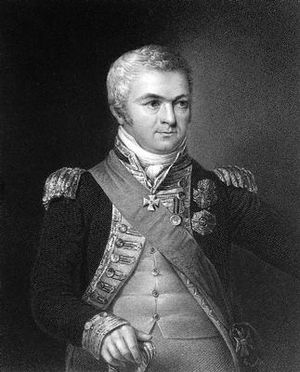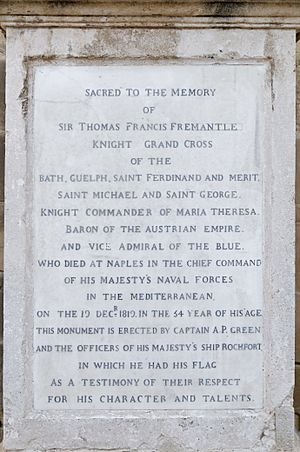Thomas Fremantle (Royal Navy officer) facts for kids
Quick facts for kids
Vice-Admiral Gracious Lord Sir
Thomas Francis Freiherr von Fremantle
|
|
|---|---|

Sir Thomas Fremantle
|
|
| Born | 20 November 1765 Aston Abbotts, Buckinghamshire, England |
| Died | 19 December 1819 (aged 54) Naples, Italy |
| Place of burial |
Garden of Don Carlo Califano, Naples, Italy
|
| Allegiance | |
| Service/ |
|
| Rank | Vice-Admiral |
| Commands held | HMS Spitfire HMS Tartar HMS Inconstant HMS Ganges HMS Neptune Adriatic Sea |
| Battles/wars | French Revolutionary Wars Napoleonic Wars |
| Awards | Knight Grand Cross of the Order of the Bath Knight Grand Cross of the Royal Guelphic Order |
Sir Thomas Francis Fremantle (born November 20, 1765 – died December 19, 1819) was a brave British naval officer. He was a Vice-Admiral in the Royal Navy. He was known for fighting in many important sea battles. He was also a close friend of the famous Admiral Lord Nelson. Thomas Fremantle even received a special title, a 'barony,' from Austria. His son, Admiral Sir Charles Fremantle, has a city named after him in Western Australia, called Fremantle.
Contents
Thomas Fremantle was born in 1765. His father was John Fremantle from Aston Abbotts, England. His mother was Frances Edwards. Thomas had a younger brother, William, who became a politician.
Thomas joined the navy when he was just eleven years old in 1777. His first ship was the frigate HMS Hussar. Because of his family's connections and his own skills, he was promoted quickly. He became a lieutenant in 1782 while serving in Jamaica. By 1790, he was a commander of the ship HMS Spitfire.
When the French Revolutionary War began in 1793, many officers were promoted. Thomas became a post-captain in May 1793. He commanded the small frigate HMS Tartar. This is when he first met Horatio Nelson. They both served at the Siege of Bastia. During this siege, Nelson lost an eye. Fremantle became known for his bravery. He sailed his ship close to the fortress walls, even though another ship had already sunk there from heavy enemy fire.
The next year, Fremantle commanded the frigate HMS Inconstant. He took part in a sea battle in the Gulf of Genoa in 1795. The French fleet was sailing towards Italy. Fremantle, even though his ship was smaller, used its speed to catch up to a large French ship called Ça Ira. This ship had been damaged in a crash. Fremantle sailed his ship right under the bow of the huge French vessel. This slowed the Ça Ira down enough for the British fleet to capture it. Nelson's ship, HMS Agamemnon, was the first British ship to arrive. This event increased the respect between Fremantle and Nelson.
In 1796, Nelson asked Fremantle to join him in Italy. They caused a lot of trouble for the French along the Italian coast. They helped British and royalist people escape to Corsica when the French army invaded. They also captured coastal areas and attacked enemy bases. They even captured the island of Elba.
While in Italy, Fremantle rescued an 18-year-old woman named Betsey Wynne from Livorno. She was from a well-known family. Fremantle married Betsey that same year. Prince Augustus was his best man.
Later that year, Fremantle fought Spanish gunboats off Cadiz with Nelson. The next year, in 1797, they were both badly wounded in the arm at the Battle of Tenerife. Nelson's arm had to be removed. Fremantle's arm was saved, but he never fully recovered its use.
While recovering at home, Fremantle thought about how to improve naval command. He sent ideas to the Admiralty about how to handle minor punishments on ships. His ideas were not used at the time, but they later helped change the navy's rules in the 1850s. Fremantle was very popular with his crew and the public. He did not stay home for long.
In August 1800, Nelson took command of the Channel Fleet. Fremantle joined him as commander of the ship of the line HMS Ganges. He earned more praise for his service at the Battle of Copenhagen in 1801. He also tried to get into politics. He lost an election in 1802 but won a seat in Parliament for Sandwich in 1806.
In 1805, Fremantle was given command of the huge 98-gun ship HMS Neptune. He joined the blockade of Cadiz, waiting for Nelson to take command. At the famous Battle of Trafalgar in October, Neptune was third in Nelson's line of ships. Fremantle's ship cut through the enemy fleet right after Nelson's flagship, HMS Victory. Neptune then fought the massive Spanish ship Santissima Trinidad. The battle left Neptune with 44 casualties, while the Spanish ship had over 300. Neptune was not badly damaged. It was able to tow the damaged Victory back to Gibraltar. Fremantle took some silver from the Spanish ship's chapel to decorate his home.

Later Career and Achievements
Fremantle spent the next five years in England. He was a member of Parliament for Sandwich from 1806 to 1807. He also served as a Lord of the Admiralty (a high-ranking naval official) during that time.
In 1810, he became a rear-admiral. He took command in the Adriatic Sea. He used his frigate squadrons (groups of fast ships) very well against French-controlled Italy and Dalmatia. When the French empire surrendered in 1814, the entire Balkan coast surrendered to him. He captured over 800 ships, which made him very wealthy.
For his great service, he received many honors. He was made a Knight Grand Cross of the Order of the Bath in 1815. He also became a baron of the Austrian Empire. Later, he was promoted to vice-admiral. From 1818, he was the Commander-in-Chief of the Mediterranean Fleet. He also received several knighthoods from Austria and Italy. He was also made a member of the Royal Guelphic Order from Hanover.
Thomas Fremantle died in December 1819 from a sudden illness. He was buried in Naples, Italy. His grave can be seen in the Garden of Don Carlo Califano.
His Sons: Continuing the Legacy
Sir Thomas Fremantle had at least four sons.
- His oldest son, Thomas, became a politician. He inherited his father's special title, a baronetcy. He was later made Baron Cottesloe for his own service to England.
- Another son, Charles Fremantle, became the captain of the ship HMS Challenger. This ship was the first of three sent from Britain to start a colony in Western Australia. The Australian city of Fremantle is named after him.
- A third son, William Robert Fremantle, became the Dean of Ripon (a church leader).
- His youngest son, Stephen Grenville Fremantle, was captain of HMS Juno from 1853 to 1858.

